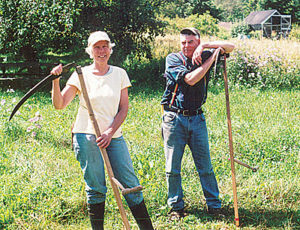 |
| Carol Bryan, with help from Richard Scott, has continued Scythe Supply, the business Bryan’s partner, Elliot Fishbein, started before his death. Scythe Supply now provides scythes to growers in every U.S. state and to many abroad. Photo by Larry Lack. |
Preserving and Reviving a Timeless Technology
by Larry Lack
The scythe, an ancient harvest tool that was a critical factor in developing specialized agriculture and human civilization, is enjoying a worldwide revival, and a farm-based business in Down East Maine is playing a significant role in that revival.
Old Testament references to scythes indicate that they were commonly used for harvesting grains and fodder crops in the Middle East well before the Christian era. The graceful shape and efficiency of the scythe were gradually improved over the centuries, and scythes were essential to food production in most parts of the world until mechanical mowers and reapers largely replaced them by the late 1800s.
But many farmers in less developed countries have continued – and still continue – to use scythes, while a smattering of contemporary farmers and gardeners in the United States and other “advanced” countries have kept scything skills and scythe production alive.
With peak oil, global warming and the implosion of the global industrial economy all pointing to the need for more regional self-sufficiency in food production, scythes are attracting more interest as practical tools and are no longer considered quaint historical curiosities that belong in farm museums.
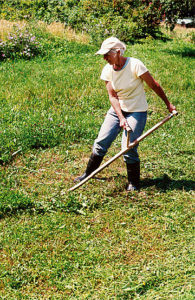 |
| Bryan mows a field at her Perry, Maine, home. She and Scott frequently demonstrate scything at MOFGA events. Photo by Larry Lack. |
Based on Shore Road Farm overlooking Passamaquoddy Bay in Perry, near Eastport, Scythe Supply is one of a handful of organizations in North America that have worked to keep the “heritage technology” of the scythe available for present day users. Seen by some as romantics fixated on a primitive and outmoded tool, these practical preservationists may prove to be lifelines for societies whose economies and technologies are faltering. For over 2,000 years the scythe helped sustain humanity, and our changing circumstances could return us to a greater reliance on scythes and other efficient manual tools.
A Growing Business
Scythe Supply was founded in 2001 by sign maker and artist-entrepreneur Elliot Fishbein after he and his partner Carol Bryan moved from Eastport to Perry where they could grow more vegetables.
A skilled woodworker and carver who loved hand tools, Fishbein had always done his mowing with an old American-made scythe. Intrigued when he heard of a small company in Tennessee that sold scythes of a different and reportedly superior design made in Austria, Fishbein immersed himself in scythe research and decided to try to start a scythe business. He learned how to use and maintain scythes, established a connection with a 500-year-old scythe factory in Austria, and began selling scythes and scythe accessories from his farm in Perry.
In 2002, within a year after he had started Scythe Supply, Fishbein was killed in a highway accident. With help from Richard Scott of Pembroke, an experienced scyther who helped Fishbein start Scythe Supply, and several employees, Carol Bryan has grown the business that her partner started into a solid enterprise with sales throughout the United States and beyond.
Best of European and Maine Manufacturing
To function optimally, scythes must be sized to their users, so customers provide measurements of their height, hip to ground and “cubit” (the distance from the back of their elbow to the tip of their middle finger). These are used to determine the length of the scythe’s “snath” (handle) and the placement of the grips that secure the scythe blade to its snath.
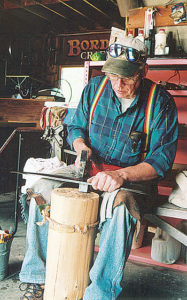 |
| Richard Scott peening a scythe blade – i.e., resetting the edge with a peening hammer. Photo by Carol Bryan. |
Bryan explains that several markets exist for scythes corresponding to their various uses. The hefty bush blade, which can slice through woody saplings up to an inch in diameter, is the choice for heavier mowing and clearing; ditch blades are for clearing light brush and heavy weeds; while grass blades are used for mowing grass and for harvesting hay and grains. Several length options are available for each type of blade.
The blades sold by Scythe Supply are still imported from the 500-year-old scythe factory in Rosleithen, Austria, near Graz. Sharpening stones (scythes must be honed fairly frequently as the scyther works) and belt holsters for carrying the stones come from the Czech Republic.
The snaths are made of white ash sourced from Peavey Manufacturing in Eddington, Maine. They’re milled near there by Holden Cabinet and Millwork in East Holden, and another Maine firm, Kingfield Wood Products, makes the handle grips.
Demos and Trades Shows Boost Sales
To help customers and potential customers learn the art of scything, Bryan and Scott offer workshops on scything at MOFGA’s Common Ground Fair in Unity, MOFGA’s Small Farm Field Day, Cobscook Community Learning Center in Trescott, Maine’s annual Agricultural Trades Show in Augusta, the Vermont Farm Show and other locations. They also welcome visitors at their Shore Road scythe store in Perry on Friday afternoons from June through September. (Please call ahead to let them know you plan to visit.)
Scythe Supply’s sales have increased steadily over the eight years the company has been in business. About 1,000 scythes and scythe kits (which include sharpening stones and a copy of The Scythe Book, a 197-page treasury of scythe lore and practical information) were sold in 2008. Roughly 70 percent of the company’s scythes are sold through its Web site; the rest are sold directly to customers at the company’s salesroom in Perry and at its instructional workshops.
Maine buyers account for about 15 percent of Scythe Supply’s sales. While most buyers are in North America, inquiries come from many countries around the world. Europeans interested in buying scythes are referred to the factory in Austria, but Scythe Supply ships 30 to 40 scythes a year to Australia and New Zealand.
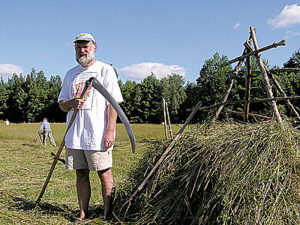 |
| Russell Libby, MOFGA’s executive director, during a scything demonstration at MOFGA’s Common Ground Education Center. English photo. |
From Harvesting Grain to Mowing Lawns
Bryan says that in recent years the company has seen a modest but steady increase in sales to those who use scythes for harvesting hay and grain crops. When a scythe is used to harvest grains, an attached grain cradle aligns the stalks so that the heads of the harvested grain all lie in the same direction as they dry. (While Scythe Supply does not presently sell grain cradles, it may do so in the future. Customers who plan to use their scythes to harvest grains are offered a set of instructions so that they can construct their own grain cradles.)
Lawns can be mowed evenly and efficiently with scythes, and Bryan says that scythes frequently do better than weed whackers when paired against them in mowing contests. She and Scott hope to hold one or more workshops aimed at lawn owners and lawn mowing companies over the coming year.
Grass can be scythed to an even length as short as 3 inches, but must be at least several inches higher than that when it is scythed to keep the blade free of the ground.
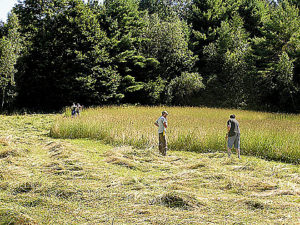 |
| Mowing a field with scythes at MOFGA’s Common Ground Education Center. English photo. |
While something of an art, scything is not hard to learn and, although it involves continuous movement, the work of scything is smooth and graceful, not strenuous or exhausting. Like other experienced scythers, Richard Scott says that on a good day he can mow for six or even eight hours without discomfort, and that the rhythmic sweeping motion of scything is a habit-forming pleasure that concentrates the mind and sometimes induces an almost meditative state.
Scott and Bryan point out that freedom from aggravating noise, gas cans and gas fumes enhances the euphoria that is a common side effect of scything, and that getting healthy exercise while mowing without adding greenhouse gases to the atmosphere is an added source of satisfaction.
A Long Maine History
Maine has contributed much to the history and lore of scything. Bryan notes that while several U.S. state flags include depictions of plows, Maine’s is the only flag on which a scythe is pictured. Once the granary for much of the Northeast, Maine figured prominently in the manufacture and use of scythes. The North Wayne Tool Company in Oakland, which closed in the late 1960s, was one of the largest manufacturers of American-style scythes.
Bryan says that many scythes were used in Maine and, after long service, worn out and discarded. She mentions that when Central Maine Power developed head ponds along Messalonskee Stream near Waterville for one of its first dams, the company reinforced a 30-foot-long earth retaining wall with hundreds of discarded scythe blades and ax heads.
Thanks to Scythe Supply the historic partnership of Maine and scythes continues. For details, visit Scythe Supply’s Web site and its workshops, or arrange to visit the Perry business.
Contact information: Scythe Supply, 496 Shore Rd., Perry, ME 04667; 207-853-4750; www.scythesupply.com.
About the author: Larry Lack is a freelance writer, community agitator and in-town homesteader who lives in St. Andrews, New Brunswick, with his lovely wife, Lee Ann, who actually does all the work.
Tips on Mowing Lawns with a Scythe
From www.scythesupply.com
Reprinted with permission.
A long blade (over 26”) is not necessary. Short blades work well and are easier to use. It takes longer to mow the lawn, but short blades don’t have the extra weight and resistance of longer blades. Long blades are not as easy to finesse or control as short blades. That means with a short blade you are less likely to clip those pretty flowers when you meant to get only the weedy things.
The longer blade will mow more grass at each stroke than a shorter blade.
Don’t expect the finished lawn to look as neat as if it were done with a rotary mower, especially the first few go-arounds. The lawn will have its high spots, holidays and divots. Give yourself time to develop the skill of close cropping a lawn.
Expect scything a lawn to take longer than cutting it with a power mower.
Your neighbors will appreciate your quiet, motorless mower. You won’t be the annoying alarm clock jarring them out of bed before breakfast. You can mow before dawn, after dark by moonlight, anytime you like without the disturbing noise of an engine.
A scythe will mow wet and/or thick grass that would bog down and stall a power rotary or hand reel mower. Use the scythe to clear an overgrown lawn before using a power or hand reel mower.
A scythe will clip close to foundations, steps, fences, stone walls, plantings, garden beds and many other obstructions that a mechanical mower can’t get close to.
Keep the heel down and the toe up. Ride the belly of the blade on the ground, keep the blade sharp, and move it in an arc. Slice with the blade, do not hack; you are not teeing off in a golf game.
Light, gentle strokes are most effective. Mowing is a shearing action. It’s more like slicing a tomato than splitting wood.
With the belly of the blade on the ground, the blade’s edge should be off the ground about 1/4 to 1/2 inch. You can adjust this height with a wedge placed between the tang and the snath.
This article was originally published in the summer 2009 issue of The Maine Organic Farmer & Gardener.
